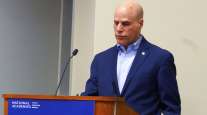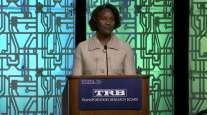Staff Reporter
Infrastructure Funding: Can Automated Weigh Station Screening Be a Revenue Source?

WASHINGTON — Automated weigh station technology can generate money for state transportation and law enforcement agencies, according to Andrew Martin, a senior research scientist at the University of Kentucky’s Transportation Center.
Automated screening technologies can photograph and record a truck’s license plate or U.S. Department of Transportation registration number. Martin delivered a presentation estimating the benefits of automated commercial vehicle enforcement at the Transportation Research Board’s annual meeting Jan. 14.
Using data from Kentucky Automated Truck Screening (KATS), as well as information gathered from screening services like PrePass and Drivewyze, Martin said that such technologies could generate millions of dollars for state agencies by helping auditors spot non-compliant carriers. There are KATS systems stationed at 17 sites throughout Kentucky.
These technologies can improve auditors’ efforts to spot offending trucks, such as ones operated by a person without an active tax license. Martin explained that, in Kentucky, auditors sample a few trucks, but don’t look at the entire population of carriers in the state. Automated technologies that collect information on trucks can offer auditors a more complete picture of the fleets that operate within a state.
The process would technically be “semi-automated,” he told Transport Topics, because someone would need to verify that all the images of trucks are correct.
“Automatic weigh station screening of commercial vehicles may guide state tax-enforcement agencies and generate revenues totaling $6.2 million per year,” Martin said.
Martin joined several other panelists in discussing the latest trends in infrastructure funding at the state level. States are leading various efforts to generate infrastructure revenue. Many states have enacted hikes to their fuel tax rates. Several have experimented with miles-based user fee programs. Connecticut voters overwhelmingly supported an amendment to create a lockbox to protect transportation funds Nov. 6.

Lederman by Eleanor Lamb/Transport Topics
Jaimee Lederman, a researcher at the University of California-Los Angeles’ Institute of Transportation Studies, said about 300 measures for some form of tax to support transportation funding went before voters during the Nov. 6 elections.
“Traditional sources of transportation funding are decreasing, and cities, counties and states are increasingly turning to alternate measures,” Lederman said.
Jacob Terry, a student at the University of Waterloo’s Department of Civil and Environmental Engineering, identified smart roads, smoother repaving and smart signage and signals as major transportation-related expenses in the future.

Terry by Eleanor Lamb/Transport Topics
“These are things most people expect you would need to communicate with vehicles and have them function effectively on the road,” Terry said.
How to deal with funding shortfalls is a persistent issue. It’s a problem at the federal level, too. The Highway Trust Fund, which finances government spending for highways, is projected to be $3 billion short of operational expense requirements of $47 billion by fiscal 2021, according to an analysis by the Congressional Budget Office in April. The fund is propped up by a federal tax of 24.4 cents per gallon on diesel and 18.4 cents per gallon on gasoline.
In July, Bill Shuster (R-Pa.), the outgoing chairman of the House Transportation and Infrastructure Committee, proposed a long-term infrastructure plan that would raise taxes on fuel and establish a volunteer vehicle-miles-traveled program. Prior to that, the White House called for $1.5 trillion for infrastructure projects over 10 years by relying significantly on backing from the private sector. Neither has advanced.




